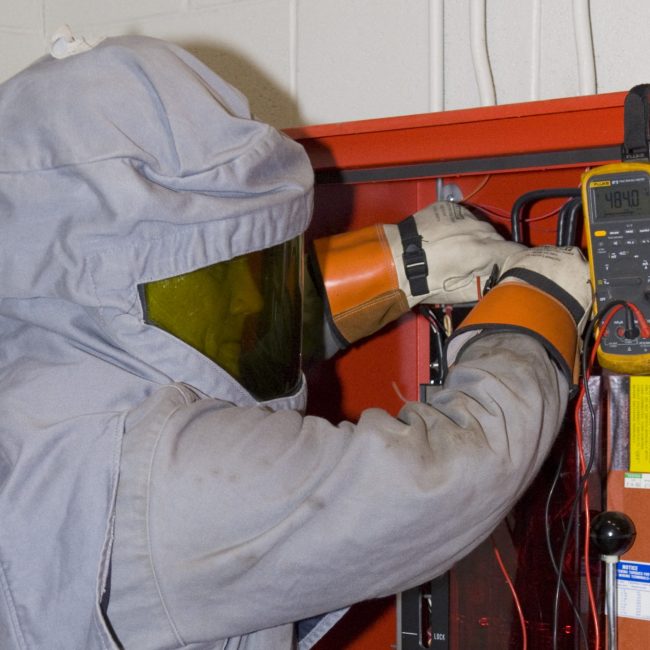Automatic Transfer Switch Maintenance
Home > Maintenance > Automatic Transfer Switch Maintenance
Automatic Transfer Switch Maintenance (ATSM) is a preventative maintenance service that is generally performed on an annual basis, in combination with an annual generator service, but can be performed as a standalone service. During the ATSM, LionHeart Field Service Engineers (FSEs) will perform various tasks, including but not limited to:
- Record pickup and dropout settings for undervoltage, overvoltage, underfrequency, over frequency, and phase imbalance. Calibration of voltage sense relays can be performed with a variac, should the ATS controls require such calibration.
- Note time delay settings for engine start delay, transfer to Source 2, neutral time delay, retransfer to Source 1, engine cooldown time delay, elevator pre-signal time delay, and others, if applicable.
- Work with building engineer to advise if adjustment to setpoints or time delays are recommended based on industry best practices.
- Inspect the condition of controls, switches, indicator bulbs, circuit boards / modules, wiring connections, linkages, limit switches, relays, and many other components.
- Document voltage, amperage, millivolt drop across contacts, readings for all phases on both Normal and Emergency sources if a power transfer is allowed.
- LionHeart FSEs will also clean interior / exterior of ATS cabinet to remove any dust or debris inside the cabinet. Lubrication of the transfer switch mechanical components is also essential to ensuring reliable automatic transfer operation.

How does an automatic transfer switch operate?
An automatic transfer switch is a piece of equipment designed to manage electrical power between two sources by continuously monitoring utility power and, in the event of a power outage, automatically starts the standby generator. During a power outage, once the automatic transfer switch senses that generator power is available, the ATS transfers to the alternate source (using the generator to power automatic operation to the emergency source) and supplies power to the critical electrical panels within the electrical distribution system, on the load side of the ATS. The automatic transfer switch continues to monitor the condition of both sources of power. Once utility power returns, the transfer switch controls will wait until power is stable for several minutes prior to returning to the utility source.
Automatic transfer switches come in a wide variety of styles and designs, to fit various kinds of power management needs and budgets. Open transition, or delayed transition, are the most common and most economical since this style has the fewest additional components and wiring, in comparison to a closed transition or bypass isolation style transfer switch. Closed transition transfer switches will connect to both sources, during transfer events, for a very brief amount of time, allowing an overlap between power sources, in a make-before-break fashion. Closed transition switches provide no interruption to power systems when transferring between two live sources. Bypass Isolation transfer switches allow for repairs or maintenance to the transfer switch mechanism without removing power from the loads through the function of bypassing to the connected source, redirecting power around the switch mechanism. Bypass Isolation and Closed transition transfer switches are frequently found in mission critical applications such as hospitals or data centers, due to their additional features.
ATSs can be used with either natural gas or diesel generators. Each have their own preferred time delays and settings, to optimize operation of the power system. Natural gas generators can exhibit instability in their operation, partially caused by the lower torque rating of natural gas engines as compared to diesel engines, as well as the carbureted nature of natural gas engines instead of direct injection. To compensate for this bit of instability, ATS settings can be adjusted and tuned by LionHeart FSEs to allow for more tolerant slip windows and wider ranges of acceptable parameters.
How often should an automatic transfer switch be tested?
LionHeart suggests testing your automatic transfer switch annually, at a minimum; ideally during the annual Automatic Transfer Switch Maintenance event while a LionHeart FSE is onsite and can verify proper operation of the equipment. Many building engineers choose to operate the ATS every month and run the generator under building load. Running the generator under building loads is an important part of maintaining proper operation of your generator. Some facilities are required by law to conduct transfer testing on a monthly basis in order to maintain compliance.
Testing more than once per month is usually unnecessary and can cause excessive wear, as well as premature failure of components after many years of successive weekly testing.
Why is an ATSM recommended?
ATSM is recommended to ensure that potential problems are noticed before a failure occurs; LionHeart FSEs accomplish this by checking for hot spots, excessive resistance across contacts, condition of circuit boards and mechanical components, and any other abnormalities. Trending of temperatures and voltages is the easiest way to determine if a problem might be starting to develop. Conducting a LionHeart ATSM service provides peace of mind to the equipment owner, by knowing that their equipment is functioning properly and in good working order so they are ready for a power outage, should one occur.
Unmatched Expertise
We believe no organization should ever be at risk due to the failure of their critical power systems. LionHeart is the team you need for peace of mind.


